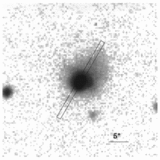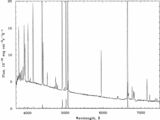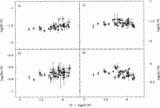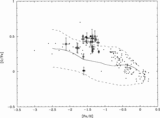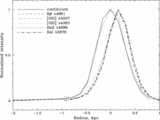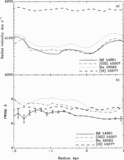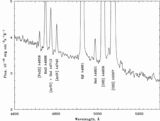Image Details
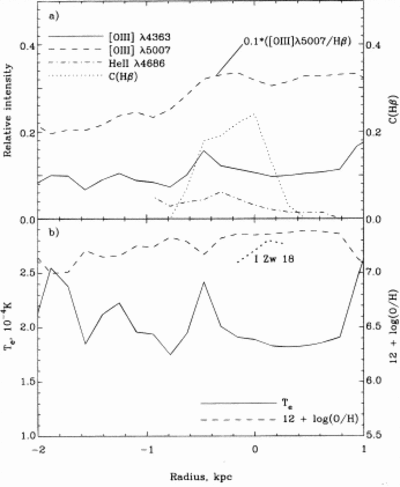
Caption: Fig. 5.
(a) Distribution along the slit in the northwest‐southeast direction of [O III] λ4363 (solid line), [O III] λ5007 (dashed line), and He II λ4686 (dot‐dashed line) line intensities, as well as extinction coefficient C(Hβ). The intensity of the [O III] λ5007 emission line is reduced by a factor of 10. The zero point is chosen at the maximum in continuum flux distribution along the slit. Northwest is to the left, 1﹩\arcsec﹩ = 261 pc. Note that [O III] λ4363 is observed in a region with diameter greater than 3 kpc and allows us to measure the electron temperature along the slit. The maximum in He II λ4686 relative intensity distribution is shifted to the northwest. We note significant extinction in the brightest part of the galaxy, which coincides with dust lanes detected by Thuan et al. (1996b) on V and I HST images. (b) Electron temperature, Te (solid line), and oxygen abundance, 12 + log (O/H) (dashed line), distributions in the H II region of SBS 0335−052. For comparison, the oxygen abundance distribution in I Zw 18 (Martin 1996) is shown by the dotted line. Note that both electron temperature and oxygen abundance in SBS 0335−052 are nearly constant across more than 3 kpc, suggesting effective mixing inside the H II region during short timescales, ≤107 yr. While the oxygen abundance in SBS 0335−052 and I Zw 18 is the same, the spatial extent of the H II region in SBS 0335−052 is several times greater as a result of a more powerful burst of star formation.
Copyright and Terms & Conditions
© 1997. The American Astronomical Society. All rights reserved. Printed in U.S.A.


